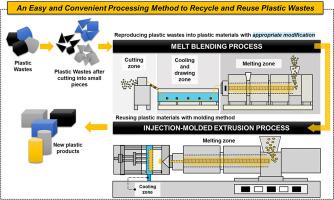Journal of Cleaner Production ( IF 9.7 ) Pub Date : 2020-08-04 , DOI: 10.1016/j.jclepro.2020.123473 Ting An Lin , Jia-Horng Lin , Limin Bao

|
In recent years, the excess amount of disposable plastic wastes has gained a concern for the environment. Polypropylene (PP) and thermoplastic polyurethane (TTPU) are both materials that can be properly heated to reform and reuse due to the inherent characteristics of thermoplastic materials. However, the using efficacy may be compromised as the waste may be overheating and thus damaged during the reheating process. Additionally, PP and TTPU are incompatible and immiscible, for which a compatibilizer - polypropylene grafted maleic anhydride (MA) was used. Hence, this study goals to investigate the synergistic effect between these materials and also discuss the compatibilized effect caused by MA. The thermal degradation behavior, melting and crystallization behaviors, and surface morphology of PP/MA/TTPU blends are evaluated under appropriate considerations. In light of the thermal degradation, the presence of thermally stable PP improves the thermal stability of TTPU accordingly. From TGA and DTG results, the addition of MA is also helpful, and therefore the third thermal degradation temperature (T3max) is increased by 5 °C averagely when compare to neat PP. T1max and T3max of PP/MA/TTPU are postponed about 2 and 4 °C when TTPU content varied from 10 to 30 wt%. SEM images show that the employment of TTPU strengthens the toughness of the surface, and with the aid of 5 wt% MA, PP and TTPU exhibit greater interfacial compatibility and better adhesion. Above all, this study aims to investigate the feasibility of using thermoplastic based on the consideration of how to sustain the excess plastic products and develop the measure to melt-blend diverse thermoplastics for reclamation. The excessive plastics via an easy and convenient melt extrusion process is expected to be regarded as an eco-friendly method for green development on mother earth.
中文翻译:

熔融过程后热塑性复合材料的可重复使用性评估和热性能的研究:聚丙烯/热塑性聚氨酯共混物
近年来,过量的一次性塑料废料引起了人们对环境的关注。聚丙烯(PP)和热塑性聚氨酯(TTPU)都是材料,由于热塑性材料的固有特性,它们可以适当地加热以重整和重复使用。但是,由于废物可能会过热并因此在再加热过程中受到损坏,因此使用效率可能会受到影响。另外,PP和TTPU不相容且不互溶,为此使用了相容剂-聚丙烯接枝的马来酸酐(MA)。因此,本研究旨在研究这些材料之间的协同作用,并讨论由MA引起的增容作用。热降解行为,熔化和结晶行为 在适当的考虑下,对PP / MA / TTPU共混物的表面形态进行了评估。考虑到热降解,热稳定PP的存在相应地改善了TTPU的热稳定性。从TGA和DTG结果来看,添加MA也是有帮助的,因此第三次热降解温度(T与纯PP相比,3max)平均提高5°C。当TTPU含量从10wt%到30wt%变化时,PP / MA / TTPU的T 1max和T 3max推迟约2和4°C。SEM图像表明,TTPU的使用增强了表面的韧性,并且借助于5wt%的MA,PP和TTPU表现出更大的界面相容性和更好的粘附性。最重要的是,本研究旨在基于如何维持多余的塑料产品并开发将多种热塑性塑料熔融共混用于回收的措施,来研究使用热塑性塑料的可行性。通过简单方便的熔融挤出工艺生产的多余塑料有望被认为是在地球上绿色发展的一种环保方法。









































 京公网安备 11010802027423号
京公网安备 11010802027423号